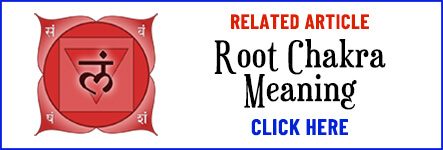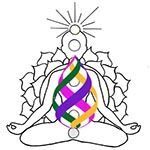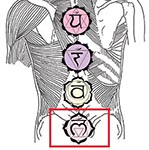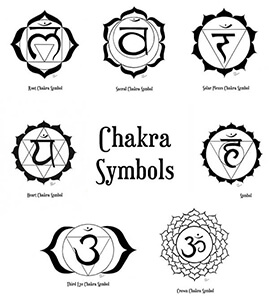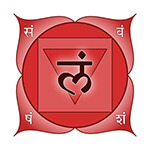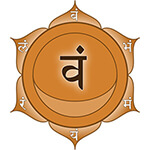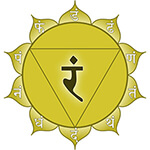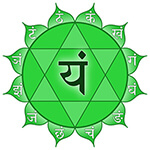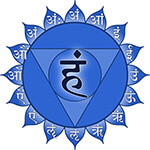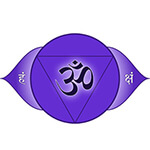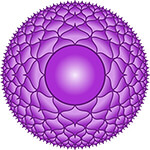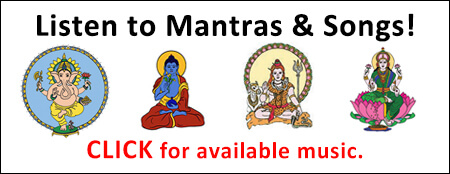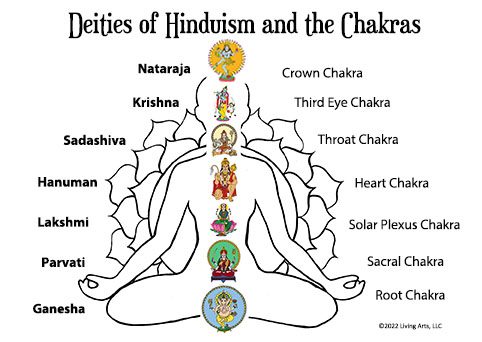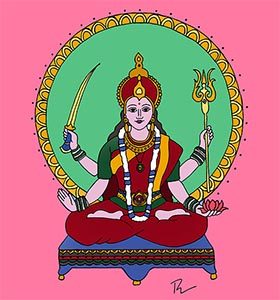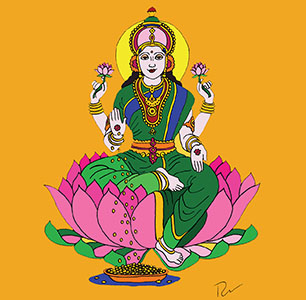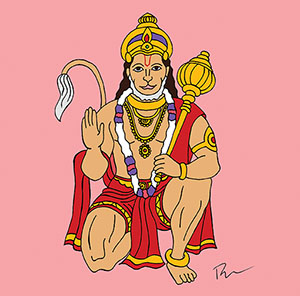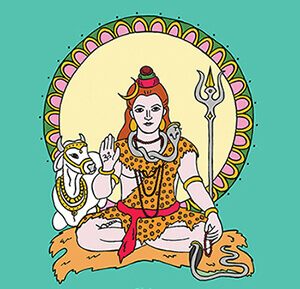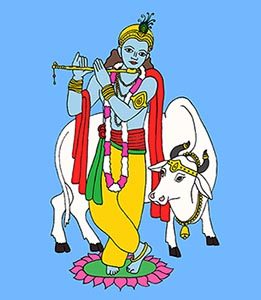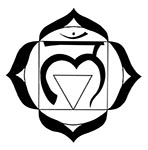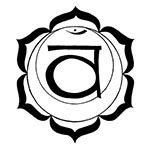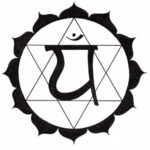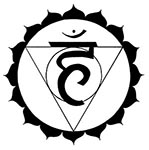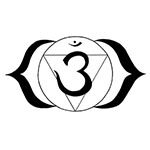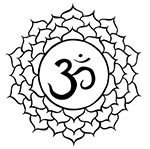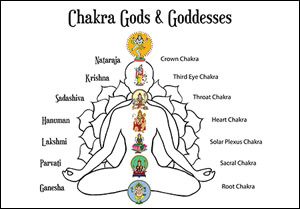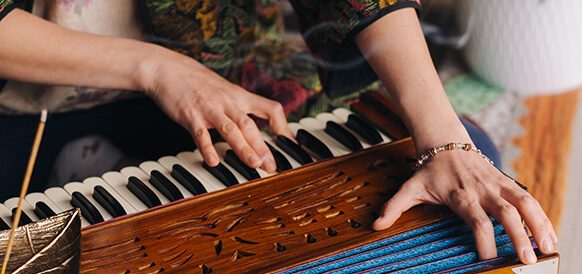
Chakra Sounds & Seed Syllables
Chakra sounds include spoken, sung, and played vibrations. The sounds for each chakra vary and reflect the role of each chakra in health, emotional balance, and spiritual development. This article will help you to understand and experience the sounds associated with the seven major chakras.
Table of Contents
Share this page with a friend!
Chakra Sounds Topics Covered
This comprehensive guide includes a chakra meditation video; information about seed syllables, musical notes, frequencies, vowels, and tones associated with the chakras; Hindu gods and goddesses for each chakra; musical instruments aligned with each chakra; and a link to a free downloadable chart summarizing the chakra sounds. Use these and resources to balance and strengthen your chakras through sound!
Introduction to Chakra Sounds
The practice of chanting as well as listening to certain types of sounds and music can be used to heal and balance the chakras. Each chakra has its own vibration. In the Vedic tradition, there are “seed syllables” connected to each chakra. Learn more and listen to these sounds below.
Watch over 200 videos on our YouTube channel!
Chakra Sounds Meditation Video
The Chakra Chant Meditation includes the seed syllables that activate each chakra along with the instrument for that chakra. Chant along with each verse or relax and use the music as a sound healing experience. The video also includes a colorful, inspiring visual trip through galaxies and the universe! Time codes are also given below if you would like to focus on a particular chakra.
Root Chakra: Seed Syllable LAM, Drums, 0:00-1:40
Sacral Chakra: Seed Syllable VAM, Flute & Woodwinds, 1:41-3:05
Solar Plexus: Seed Syllable RAM, Harmonium & Organ, 3:06-4:33
Heart Chakra: Seed Syllable YAM, Violin & Strings, 4:34-6:00
Throat Chakra: Seed Syllable HAM, Horns, 6:00-7:25
Third Eye Chakra: Seed Syllable OM, Piano, 7:26-8:53
Crown Chakra: Seed Syllable AH, Conch Shell, 8:54-10:20
"This is wonderful! It’s such a healing mantra for me and I feel like my whole body has been reset. The sound is so clear!"
A.C., Bozeman, MT, USA
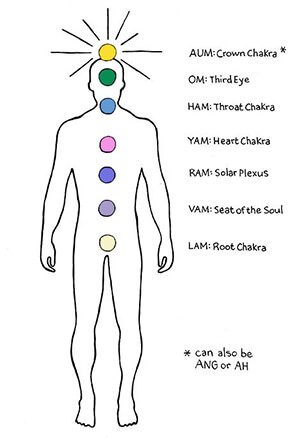
More on the bija syllables in One Word Mantras.
Chakra Sounds: Bija Seed Syllables
Each of the seed syllables for the chakras can be used independently or combined in mantras. The seed syllables for the seven main chakras are as follows:
LAM (root chakra)
VAM (sacral chakra)
RAM (solar plexus chakra)
YAM (heart chakra)
HAM (throat chakra)
OM (third eye chakra)
AUM, AH or ANG (crown chakra)
Many mantras begin with OM, a sound said to represent the hum of the universe and to focus the mind. Mantras often end with “Svaha.” This word is similar to “Amen” in the West, indicating completion or agreement. “Svaha” literally means a fire offering. Mantras may also end with “Namaha” meaning “I acknowledge, I honor or I bow.”
Root Chakra Sound: LAM
The root chakra seed sound is LAM, pronounced “luhm” or “lung.” This sound specifically activates the energy of the root chakra. The root chakra is at the base of the spine. This is the chakra of safety and security. The name for the root chakra in Sanskrit is Muladhara.
Meaning of the Root Chakra Name
“Mula” means “root” and “adhara” means “base or support.” In the Hindu tradition, the base chakra is depicted as a lotus flower with four petals. The four petals of the base chakra are generally viewed as mind, intellect, consciousness and ego. Learn more in our article on Chakra Names.
Root Chakra and the Physical Body
The base or root chakra is our fundamental connection to the physical plane. This is the place where ancestral memories reside. The root chakra governs the lower part of the body, including the feet, legs, knees, hips, lower back and lower spine. These areas of the body establish balance and stability. Listen to the root chakra mantra “OM LAM Namaha” in the article Chakra Mantras.
Sacral Chakra Sound: VAM
The sacral chakra seed syllable or bija sound is VAM, pronounced “vuhm” or “vung.” This chakra is defined as the seat of the self and the relationship of the self with others. The sacral chakra is said to house the unconscious. This is sometimes symbolized as the ocean. The sacral chakra is the realm of exchange and finances. If this energy is used improperly, addiction to sex or gambling can result.
Meaning of the Sacral Chakra Name
The second or sacral chakra is known as Svadhisthana. Svadhishthana means “one’s own abode.” The sacral chakra is also known as the seat of creation. For this reason, the sacral chakra is sometimes called the seat of the soul. More details about the sacral chakra can be found at Sacral Chakra Meaning. Listen to the sacral chakra mantra “OM VAM Namaha” in the article Chakra Mantras.
Sacral Chakra and the Physical Body
The organs associated with the sacral chakra are the reproductive organs, the kidneys and the bladder. As the center of reproductive ability, the sacral chakra is also the seat of artistic creation. The role of the kidneys in filtering blood is absolutely vital for optimal health. The kidneys also control blood volume by regulating salts and water. Learn to use stones and crystals to support these organs and the sacral chakra in Chakra Stones and Crystal Meanings.
Solar Plexus Chakra Sound: RAM
The solar plexus chakra seed sound is “RAM,” pronounced “ruhm.” Interestingly, this is also the name of a prominent Hindu deity called Ram or Rama. Explore the story of Ram in the article Sita Ram Mantra. When purified, this is the chakra of inner peace. The solar plexus chakra is located at the naval. This is the center of intuition, the place where you get a “gut feeling.” Listen to the sacral chakra mantra “OM RAM Namaha” in the article Chakra Mantras.
Meaning of the Solar Plexus Chakra Name
The third chakra or solar plexus chakra is known as Manipura. The name translates as the “city of jewels.” “Mani” means “gem” while “pura” means “city.” The solar plexus chakra is connected to both service and desires. The solar plexus is related to the individuation process and the ability to take on responsibility. This chakra can be a place of personal authority and emotional strength. Find out more about the solar plexus chakra in Solar Plexus Chakra Meaning.
Solar Plexus Chakra and the Physical Body
The solar plexus chakra governs the power of transformation and assimilation. The solar plexus chakra is the center of digestion of food on the physical level as well as the digestion of thoughts and emotions on the mental and emotional levels. If misused, chronic digestive issues may result. Learn more in the article Chakras and Organs of the Body.
Related Chakra Articles
Heart Chakra Sound: YAM
The seed sound for the heart chakra is YAM, pronounced “yuhm.” As the seat of love and devotion, the heart expresses charity, compassion, and kindness. The heart is also a focus for beauty and culture. The energy of this chakra integrates opposite forces or brings two parts together. The heart chakra is symbolized by a twelve-petaled lotus with interlocking triangles. This is a depiction of yin and yang or male and female. Listen to the sacral chakra mantra “OM YAM Namaha” in the article Chakra Mantras.
Meaning of the Heart Chakra Name
The fourth chakra is the heart chakra or the Anahata chakra. In Sanskrit, “Anahata” means “unhurt, unstruck, unbeaten.” At the same time, Anahata means “pure” or “clean.” The heart chakra is believed to house an inner chakra or chamber where the spark of life resides. In the Western tradition, this is known as the three fold flame or the inner chamber of the heart. In the East, this is sometimes called Brahma’s Cave. Learn more in Chakra Names and Sanskrit Meanings.
Heart Chakra and the Physical Body
The physical organs associated with the heart chakra are the heart itself, the circulatory system and the lungs. Sounds associated with the lungs include “hamsa” and “soham.” These sounds mimic the action of inhalation and exhalation. They can be used to focus the mind while concentrating on the breath. The word “hamsa” also means “swan.” This can be used as a title of respect as the swan is viewed as one of the highest birds. Learn more about the heart chakra in the article Heart Chakra Meaning.
Watch over 200 videos on our YouTube channel!
Throat Chakra Sound: HAM
The Sanskrit seed sound for the throat chakra is HAM, pronounced “hum.” The throat chakra symbol has sixteen petals. In the center is a triangle pointing downward and a white circle representing akasha or ether. The throat chakra is connected to creativity and self-expression as well as the actions of speaking and chanting. The throat and thyroid are where emotions, intentions, praise and criticism are expressed. Listen to the mantra “OM HAM Namaha” in Chakra Mantras.
Meaning of the Throat Chakra Name
The fifth chakra is the throat chakra or the Vishuddha chakra. In Sanskrit, Vishuddha means “especially pure.” The throat chakra is the place where energy is qualified through sound for blessing or bane with every word spoken. Thus, the throat is the place of greatest vulnerability and greatest strength. The throat chakra and thyroid are also connected to creative expression.
Throat Chakra and the Physical Body
The thyroid gland plays a major role in metabolism, growth and vital body functions such as heart rate and body temperature. Chanting is an ideal tool for supporting the health of the thyroid gland since the vibrations of chanting and singing pass directly through the thyroid.This chakra is associated with the neck, thyroid, esophagus, teeth, mouth and the ears. Learn more in Throat Chakra Meaning.
Third Eye Chakra Sound: OM
The seed sound for the third eye chakra is “OM,” pronounced “ohm.” The sixth chakra is the third eye, the seat of spiritual vision. The third eye is the center of imagination. The word “imagination” itself means the ability to hold an “image” firmly in mind. This is the first step towards bringing that form into manifestation. This practice of visualization is also a proven technique in sports, musical performance, and other endeavors. Thus, strengthening the third eye aids in both intellectual and artistic pursuits.
Meaning of the 3rd Eye Chakra Name
The Sanskrit term for this chakra is Ajna, which means “command” or “perceive.” The third eye, usually associated with clairvoyant abilities, can be developed with yoga, meditation and the practice of chanting. Though primarily known as the seat of vision, the third eye chakra is also connected with hearing. Explore this topic further in Third Eye Chakra Meaning.
3rd Eye Chakra and the Physical Body
The pineal gland or third eye is associated with this chakra. In most people, the degeneration of the pineal gland begins at the age of six or seven and continues until puberty. Some sources believe this is why children over the age of six or seven have a diminished ability to sense the spiritual world. They may no longer have “invisible playmates” or remember what happened “before they were born.” Listen to the sacral chakra mantra “OM Namaha” in the article Chakra Mantras.
FREE download: Full set of the 7 chakra symbols.
Crown Chakra Sounds: AUM, AH or ANG
There are multiple seed sounds attributed to the crown chakra. Some believe the crown is not a single chakra, but a cluster of chakras. The seed sounds are AH, NG, and AUM. Listen to the sacral chakra mantra “OM AH Namaha” in the article Chakra Mantras.
Meaning of the Crown Chakra Name
The crown chakra is the seat of enlightenment, known in Sanskrit as the Sahasrara chakra. Sahasrara means “thousand-petaled.” According to Eastern traditions, the crown chakra is related to god-consciousness (samadhi) and the transforming powers of the divine. The crown can be viewed as the father, or spirit energy, drawing the mother, or earth energy, from the lower chakras upward.
Crown Chakra and the Physical Body
On the physical level, the crown is related to the nervous system and the brain. The brain has long been viewed as the seat of learning and intelligence. Studies now show that the brain retains elasticity far better than previously thought. Lifelong learning and exercise help to keep the brain functioning at an optimal level into the final decades of life. There is also a connection to the pineal and pituitary glands (similar to the third eye) and to the hypothalamus. Discover more in Crown Chakra Meaning.
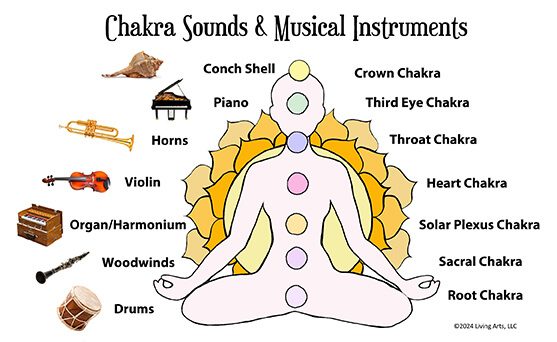
Chakra Sounds and Musical Instruments
There are musical instruments that produce sounds which can be used for balancing each chakra. Sound healing with musical instruments goes back to ancient history. The Greeks are believed to have used music to cure mental disorders. The Egyptians had acoustic chambers that are still being explored for the power of their sonic resonances.
Categories of Chakra Instruments
Though recommendations differ in various systems, there are some general categories of instruments that correspond to each chakra. These musical instruments are also typical for certain kinds of music and rhythms. These are discussed below from the root chakra to the crown chakra.
Root Chakra: Drums
Sacral Chakra: Woodwinds
Solar Plexus: Organ
Heart Chakra: Violin, Strings
Throat Chakra: Horns
Third Eye Chakra: Piano
Crown Chakra: Conch Shell
Root Chakra Musical Sounds
The musical instrument associated with the root chakra is the drum. The drum establishes the foundation and rhythm for music just as the root chakra creates the base for all of the other chakras. The Hindu deity most closely associated with the root chakra is Ganesha. Other gods and goddesses connected to the chakras are covered in Chakra Deities: Gods and Goddesses.
Drums for the Root Chakra
Drums and percussion instruments are believed to be the oldest instruments on earth. Archeologists have found drums that are 9,000 years old. However, people are thought to have created simple wooden blocks to hit together in even earlier times. The beating of a drum is a universal practice to bring a group literally into the same rhythm. This relates to the issues of safety, community and security associated with the root or base chakra.
Drum Symbolism and Hindu Gods
In the Hindu tradition, Shiva is a god who plays a drum. One form of Shiva is Nataraja, the cosmic dancer. Mantras to Nataraja include references to the sound of his dancing feet (dhimi dhimi) and the sound of his beating drum (bam bam or bham bham). The drum symbolizes the power of creation and his feet dancing on the earth symbolize the process of grounding in the material world. Shiva’s second foot is usually lifted, a symbol of release from limitations. Hear mantras to Shiva.
Rhythm of Root Chakra Music
The four petals of the root chakra correspond to the 4/4 rhythm (four beats per measure of music). This is the rhythm of marches and military fanfare. It is also the meter for much of Western rock and other popular musical styles. One of the issues with rock music is the syncopation of the 4/4 rhythm, which drives the energies of the chakras downward rather than upward. This runs counter to the aim of most spiritual practices of raising the energy from the root chakra to the crown.
More About the Lower Chakras
Sacral Chakra Musical Sounds
The sacral chakra is connected to wind instruments (flutes, clarinets, bassoon, bagpipes). Woodwind instruments have been in use since before modern farming began 12,000 years ago. Bagpipes were originally made from animal skin but now are usually made of a synthetic like Goretex.
Role of Woodwinds in Music
Orchestral woodwinds including the flute, oboe, bassoon and saxophone were developed in Europe during the 17th through 19th centuries. The flute is the oldest instrument capable of producing more than one tone. Woodwinds are often used in chamber orchestra music, typically playing classical music. Clarinets and saxophones, however, have often been featured in jazz music as well.
Modern Woodwinds
Woodwind instruments were originally made of wood, though many are now made of plastic, metal or a combination of both. Many woodwind instruments use a mouthpiece with a reed. This is a thin piece of wood that vibrates. The sound is then amplified by the instrument.
Krishna and His Flute
Krishna is a Hindu god often depicting playing a flute. His sweet melodies are said to woo the soul back to God. Shortly after Krishna was born, he was sent to live in the country to protect him from the evil king Kamsa. Kamsa believed that Krishna would overthrow him and intended to kill him. For this reason, Krishna grew up living an idyllic rural life as a cow herder, often playing his flute to entertain the young milkmaids. Learn more and listen to a Krishna Mantra.
Symbolism of Woodwind Instruments
The woodwind instruments are closely related to the power of the breath. God is associated with the breath, fire and wind in many traditions. The idea that God breathes life into inanimate form is also a common theme in many traditions. Mantras for the lungs often focus on the breath, creating a smooth inhale and exhale to strengthen the lungs and calm the mind. These simple mantras help to create a vibration that connects your lungs, heart and spirit. Learn more about Healing Mantras.
Solar Plexus Chakra Musical Sounds
The solar plexus is most affected by organ music and similar instruments such as the harmonium (also known as a hand organ). Learn more about the Solar Plexus Chakra. The harmonium is believed to have been invented in the late 1700s in Copenhagen.
Origin of the Harmonium
The instrument was originally used by Christian missionaries in Europe and the Americas who either could not afford or could not transport larger organs. Harmoniums were brought to India about a century later in the late 1800s. The harmonium was temporarily banned from music broadcasts in India in the 1940s. This was because the subtleties of Indian music could not be reproduced with the fixed reed tones and the western scale of twelve semitones. However, the fixed nature of the tones was also a great benefit: the instrument did not lose tuning in hot or humid weather.
What is Kirtan Music?
The harmonium is now the most commonly used instrument in northern India and the most popular kirtan instrument around the world. Kirtan is a form of sacred singing in a group setting, often in call and response. The word “kirtan” comes from Sanskrit and specifically refers to the practice of singing mantras. Kirtan is a growing phenomenon in the West, often associated with yoga studios or meditation centers. Learn more in Kirtan Music & FAQs.
Organs and Sacred Music
Organ music in West is usually associated with hymns and sacred music. Thus, the connection to the harmonium in the early days of missionary activity in North America as mentioned above. The sound of an organ is powerful and soothing at the same time, perfect for the solar plexus chakra. Explore other aspects of this chakra in Solar Plexus Chakra Meaning.
Solar Plexus Chakra and the Goddess Lakshmi
The solar plexus chakra is also associated with wealth and abundance. In the Hindu tradition, the goddess Lakshmi bestows gold coins, rice and other necessities and luxuries on her devotees. Learn more about mantras to the Hindu Goddess of Wealth.
More About the Upper Chakras
Heart Chakra Musical Sounds
The heart chakra is often associated with the string instruments (violin, cello). The string instruments are capable of imitating the human voice or even extending the human voice. As the seat of love, the heart chakra is highly expressive, as are these instruments. The importance of this connection is indicated is the idiom “playing on my heart strings.”
Ancient and Modern Stringed Instruments
The earliest known stringed instrument is the lyre, dating back to 4,500 years ago. This was a folk instrument in central Asia. Many string instruments consist of a body or gourd shape with a long neck, multiple strings and a bow. The body or sound box can be round, square or pear-shaped. The strings have often been made of animal gut. The strings are now made of steel, nylon or synthetic polymers.
World’s Beloved Instrument: Violin
The violin plays a premier role in an orchestra. They are well-suited to carrying the melody in much of classical music. A full orchestra may have as many as thirty violins divided between first and second violins. The leader of the first violins is the leader of the orchestra. Second violins often support the melody of the first violins by playing harmony or the same melody at a lower pitch.
Goddess Saraswati and the Veena
The veena is an ancient classical stringed instrument of India, played by the goddess Saraswati. The veena is plucked rather than bowed. The veena has three to seven strings and twenty-four frets. A large gourd at the base creates resonance. The goddess Saraswati is associated with music, literature, poetry and speech or debate. To be of the highest quality, these things must come from the heart.
Hindu God of the Heart Chakra
The Hindu god associated with the heart chakra is Hanuman. Hanuman is a money-faced Eastern superhero with multiple powers. Hanuman’s powers stem from his pure devotion, also indicating the central nature of the heart. Learn more about the Hanuman Yantra, a sacred symbol similar to a mandala, or listen to a Hanuman Mantra.
Throat Chakra Musical Sounds
The throat chakra is strengthened by horn instruments. These instruments can be loud and piercing, often used for announcing messages: time to get up, we have arrived, the event is beginning, and so forth. Horn instruments began as hunting horns, originally made from animal horns. The word “horn” in German is “cor” in French and “corno” in Italian. These are all references to animal horns.
Strengthening the Throat Chakra with Horn Music
Horns are connected symbolically to speech and communication through the throat. Horns send a clear tone that is usually adjusted by the breath and mouth position. Some horns such as the French horn have a limited number of keys to change the pitch of the tone. Listening to horn music can strengthen the throat chakra.
Center of Speech and Communication
The throat chakra is connected to creativity and self-expression as well as the actions of speaking, chanting and singing. This chakra is associated with the neck, thyroid, esophagus, teeth, mouth and the ears. The throat and thyroid are where emotions, intentions, praise and criticism are expressed. Learn more about the meaning of the Throat Chakra and watch a video on healing the throat chakra and thyroid: Mantras, Money and the Thyroid.
Third Eye Chakra Musical Sounds
The third eye is connected to piano music. The complexity and expressiveness of the piano relates well to the qualities of the third eye. The piano is a fairly recent invention, evolving from the plucked harpsichord around 1700AD. This invention was largely the work of Bartolomeo Cristofori in Padua, Italy.
Third Eye Energy of the Piano
Played with both hands and feet, the piano gives a wide range of tones. The pedals create sustained sound and soften the tone. The original name for the piano was the “pianoforte.” This simply means the “soft-loud” instrument. The sound of a piano is made by small hammers striking multiple stings. This combines the energy of percussion with the subtlety of strings. Most pianos have eighty-eight keys with over 200 strings.
The Third Eye and Spiritual Vision
Piano music varies widely, ranging from simple melodies to complex harmonies. This connects to the third eye ability of discernment. The third eye is the focus for vision, both in the present and prophetic or psychic abilities. The piano or keyboard is a fundamental instrument for most musicians, composers and conductors. Likewise, the third eye is the place where we create our own future by what we choose to see and visualize.
Crown Chakra Musical Sounds
The crown is associated with the sound of the conch shell. A conch shell was found in a cave containing prehistoric drawings in France. The shell is believed to be 17,000 years old. Other conch instruments have been found in the Mediterranean region, across Europe, in India, the Americas, Japan and Tibet.
Conch Shell and the Golden Ratio
The conch shell shape is a spiral closely connected to the Golden Ratio. Shells have been used as religious object since ancient times. The positive psychological connections to the sound of a conch shell include hope, courage, and optimism.
Music for Liberation and Freedom
The conch is sometimes called a “seashell trumpet” or “shell trumpet.” The conch shell is an effective signaling device, sometimes used as a war trumpet. On a spiritual level, the sound can signify liberation and freedom. The conch shell is part of many rituals in Hinduism. This includes funerals, sacred festivals and pujas (worship rituals).
The Crown Chakra and the Cosmic Dancer
Nataraja is the dancing form of Shiva, a joyful being spinning and dancing through creation. Shiva is often shown with a serpent around his neck, a crescent moon as an adornment, the river Ganges flowing from his hair or flowing nearby, the trishula as his weapon, and a damaru (drum) nearby. Learn more about the sounds and seed syllables for the crown chakra in the article Chakra Sounds.
Read full article on Chakra Toning & Vowels.
Chakra Toning & Vowel Sounds
In addition to the chakra bija seed syllables discussed above, toning sounds for the chakras also include vowel sounds. The vowel sounds connected to each chakra and the role of vowel sounds in mantras are covered in detail in the article Chakra Toning & Vowel Sounds. The practice of toning and additional information about chakra vowels are also covered. A summary of these sounds are listed below:
Root Chakra Vowel Sound: UH
The root chakra governs the lower part of the body, including the legs, hips, lower back and lower spine. These areas of the body establish balance and stability. These are the organs and systems that provide a strong foundation for physical health and a platform for our presence in the world. The vowel sound UH affects the feet, knees, pelvis, skeletal system and muscular system. Learn more in the article Root Chakra Meaning.
Sacral Chakra Vowel Sound: EW
The sacral chakra is focused on relationships. This includes one’s relationship with oneself as well as others. The sacral chakra is known in Sanskrit as Svadhishthana, meaning literally “one’s own place.” The sacral chakra is the realm of communication, exchange and finances. This chakra and the vowel sound EW are connected to the reproductive organs, lower back, large intestines and kidneys. More details in the article called Sacral Chakra Meaning.
Solar Plexus Chakra Vowel Sound: OH
The solar plexus chakra governs the power of transformation and assimilation. The solar plexus chakra is the center of digestion of food on the physical level as well as the digestion of thoughts and emotions on the mental and emotional levels. The solar plexus is the fire center, often symbolized by the colors yellow or red and a sun-like image. The solar plexus is enhanced by the vowel sound OH affecting the liver, pancreas, stomach and adrenals. Find out more in Solar Plexus Chakra Meaning.
Heart Chakra Vowel Sound: AH
Traditions around the world place great importance on the significance of the heart. Many believe the heart has emotional significance as well as spiritual meaning. In the spiritual dimension, many traditions believe that the spark of life resides is an inner chamber associated with the heart. The physical organs connected to the heart chakra and the vowel sound AH are the physical heart, circulatory system and lungs. Learn more in the article Heart Chakra Meaning.
Throat Chakra Vowel Sound: EYE
The throat chakra is the seat of power on the energetic level. In this place we qualify the fundamental energy of life for blessing or bane with every word spoken. Thus, the throat is the place of greatest vulnerability and greatest strength. The vowel sound EYE is connected to the thyroid, vocal chords, esophagus, tonsils and larynx. Learn more about the throat chakra in Throat Chakra Meaning.
Third Eye Chakra Vowel Sound: AA or AYE
There are several organs associated with the third eye chakra and the vowel sound AA. These organs all bring in sensation for interpretation by the brain. The pineal gland is the organ associated with the third eye chakra that receives the most attention. Some traditions say that the soul enters and leaves the physical body at birth and death through the pineal gland. Organs associated with the third eye include the eyes, ears, brain and endocrine system. Explore this topic further in Third Eye Chakra Meaning.
Crown Chakra Vowel Sound: EE
The crown chakra is revered as the seat of enlightenment. This chakra is the thousand petaled lotus of wisdom in its myriad forms. There is some overlap between the organs associated with the third eye chakra and those associated with the crown chakra. The crown chakra is connected to the brain, nervous system, hypothalamus, hair, nails and skin. Discover more in Crown Chakra Meaning.
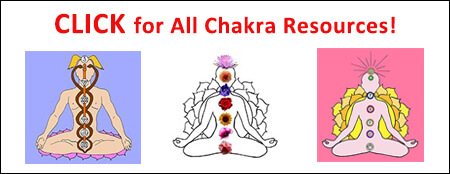
Chakra Sounds and Musical Notes
Chakras and musical notes have been paired in a number of ways. A simple system is to assign sequential notes from the C Major scale to each of the chakras from the root to the crown: C (root), D (sacral), E (solar plexus), F (heart), G (throat chakra), A (third eye) and B (crown chakra). However, the science of sound goes even deeper than this basic parallel construction. The musical notes for the chakra can be correlated to the Western solfege system (DO-RE-MI, etc.) and the Eastern sargam system (SA-RE-GA, etc.).
Indian Sargam System
Solemnization or solfeggio is the practice of using syllables to teach pitch and sight reading through recognition of the different steps of the scale. This practice originated in ancient India with the system known as sargam: SA, RE, GA, MA, PA, DHA, NI, SA. Using this system, if you begin on the note C, the sounds would correspond to musical notes as follows: SA=C, RE=D, GA=E, MA=F, PA=G, DHA=A, NI=B and back to SA on the C an octave higher than the first C.
DO-RE-MI and Musical Notes
A Benedictine monk named Guido d’Arezzo invented the system used with Western music: DO, RE, MI, FA, SO ,LA, TI and the return to DO. Guido was familiar with the Indian sargam. How this can be used to learn to sing pitches was demonstrated in the classic movie The Sound of Music: “When you read, you begin with A-B-C. When you sing, you begin with DO-RE-MI…”
Solfeggio Systems and Chakra Sounds
Guido used this system to help monks learn extensive and complex Gregorian chants. Each of these systems use a sound associated with a chakra beginning with the root chakra and ending at the crown chakra. Learn more in Chakras and Musical Notes.
Download artwork on our FREE STUFF page!
Chakra Sounds & Hindu Gods and Goddesses
There are also Hindu deities associated with each chakra. The deities represent particular vibrations or aspects of consciousness. There appear to be coded formulas in the names of the Hindu deities as well as their mantras that directly stimulate the chakras and the meridian system. Mantras, chants and bhajans to the Hindu deities are wonderful way to experience chakra sounds.
Learning About the Hindu Deities
The deities described below are those most commonly selected as associated with the chakras from the large number of Hindu deities. More information about the deities connected to each chakra and examples of mantras using their names are included in the article Chakra Gods and Goddesses.
Root Chakra Sounds & Hindu Deities
The deities Ganesha, Brahma and Indra are associated with the root chakra. These deities help to establish a foundation: Brahma is the creative aspect of God, Indra belongs to the heaven above, and Ganesha helps to overcome obstacles here on earth.
Root Chakra Sounds: Ganesha
Ganesha is another prominent figure in chakras and deities. Ganesha is often invoked at the beginning of an undertaking or an event. Ganesha is also a patron of writers and learning. Ganesha became a popular deity in the 2nd to 5th centuries AD. He is found in various traditions including Jainism and Buddhism. For more information and music videos, see Ganesha Mantras.
GANESHA MANTRA: Om Gung Ganapataye Namaha
Root Chakra Sounds: Brahma
Brahma is the Hindu creator god also known as the Self Born, the Lord of Speech, and the creator of the four Vedas. Brahma is the consort of Saraswati, the goddess of knowledge and wisdom. Brahma is traditionally depicted with four faces and four arms.
BRAHMA MANTRA: Om Eim Hrim Shrim Klim Sauh Sat Chid Ekam Brahma
Root Chakra Sounds: Indra
Indra is the king of heaven. He is associated with lighting, thunder, storms, rain and rivers. Indra rides on an elephant, symbolizing compassion, intelligence, and ancient wisdom. An elephant with seven trunks is sometimes depicted, representing all seven of the chakras or energy centers in the body.
INDRA MANTRA: Om Namo Bhagavate Rajadevaya
Root Chakra Sounds: Goddess Kundalini
The Sanskrit word “kundalini” means “coiled like a snake.” The snake is a common symbol of the kundalini, the energy curled at the base of the spine. As the kundalini moves upward, the energy flows through the seven major energy centers or chakras. The kundalini energy has been personified as a goddess in many different forms. The Goddess Kundalini is sometimes called Adi Parashakti. This literally means the “first and highest feminine energy.”
KUNDALINI MANTRA: Kundalini Mata, Kundalini Mata
Related Article: Learn more about the Goddess Parvati!
Sacral Chakra Sounds & Hindu Deities
The sacral chakra is associated with deities including Vishnu, his consort Rakini and the goddess Parvati. There are others, but these are three of the main sacral chakra deities.
Sacral Chakra Sounds: Goddess Parvati
Parvati is the Hindu goddess of fertility, love and devotion as well as divine strength and power. She is the gentle and nurturing aspect of the goddess energy and the consort of Shiva. Parvati is part of a trinity of Hindu goddesses that also includes Lakshmi and Saraswati, the goddess of knowledge and learning. Learn more and hear a mantra to Parvati.
PARVATI MANTRA: Parvati Parashakti Parvati, Jai Parvati Shakti Mata
Vishnu: Sacral Chakra Deity
Vishnu is an incarnation of Krishna. In this incarnation, he is the consort of Lakshmi, the goddess of wealth. Vishnu is known as the preserver. He is one of the three persons of the Hindu trinity: Brahma (creator), Vishnu (preserver) and Shiva (destroyer).
VISHNU MANTRA: Agni Mangalam, Vayu Mangalam, Bhumi Mangalam, Mangalam Bhagavan Vishnu; Surya Mangalam, Giri Mangalam, Jagat Mangalam, Mangalam Bhagavan Vishnu
Rakini: Sacral Chakra Goddess
Rakini is a goddess with two heads representing the duality between the external and internal worlds. This duality is also symbolized in light and dark, male and female, yin and yang, night and day, expansion and contraction and so forth.
RAKINI MANTRA: Om Rakini Namaha
Related Article: Learn more in about the Goddess Lakshmi!
Solar Plexus Chakra Sounds & Hindu Deities
The solar plexus chakra is associated with the deities Ruhdra, his consort Lakini, and the goddess Lakshmi. The solar plexus is the fire center, often symbolized by the color yellow or a sun-like image.
Lakshmi: Solar Plexus Chakra Goddess
Lakshmi is the goddess of wealth, fortune and prosperity. Her name is derived from a Sanskrit word meaning goal, aim or sign. In addition, Lakshmi is usually shown seated or standing on a lotus. The lotus symbolizes creation, beauty, harmony, diversity, stability, and support. Hear this mantra to Lakshmi in the Chakras and Deities article.
LAKSHMI MANTRA: Om Hrim Shrim Lakshmi Bhayo Namaha
Rudra: Solar Plexus Chakra Deity
Rudra is a Hindu god appearing in the Vedas, ancient sacred scriptures. He has both destructive and beneficial aspects. Rudra is the divine archer, shooting arrows of disease and death. He is also a healer and source of remedies for ailments. Rudra is a form of Shiva.
RUDRA MANTRA: Om Namah Shivaya
Lakini: Solar Plexus Chakra Goddess
Lakini is a benefactor goddess and the consort of Rudra. Lakini has four arms. Three of her hands hold symbolic items (a thunderbolt, an arrow, and fire). her fourth hand is held in the gesture or mudra of granting wishes and dispelling fears.
LAKINI MANTRA: Om Lakini Namah
Related Article: Learn more about Hanuman!
Heart Chakra Sounds & Hindu Deities
Deities associated with the heart are Hanuman in the Eastern tradition and the Holy Spirit in the West. Mantras for the heart chakra emphasize the heart as the seat of love and devotion. The heart expresses charity, compassion, and kindness. The heart is a focus for beauty and culture. The heart brings the awareness of community and compassion for others.
Hanuman: Heart Chakra Deity
Hanuman is a key deity in the Hindu tradition associated with the heart chakra. Hanuman is the monkey god, hero of epics and stories in Hinduism, Jainism and Buddhism. Hanuman is the ardent devotee of Lord Rama, and he plays a central role in the epic poem Ramayana.
Patron of Martial Arts and Scholarship
Hanuman is sometimes depicted as the patron of martial arts, wrestling, and acrobatics. I think of Hanuman as an Eastern superhero, somewhat akin to Superman or Spiderman or Batman. He is also the patron of meditation and scholarship. Listen to the Hanuman mantra and other mantras for the chakra deities at Chakra Gods and Goddesses.
HANUMAN MANTRA: Hanuman Jaya Ram, Jaya Sita Ram
Kuan Yin: Goddess of Mercy
The goddess Kuan Yin appears in East Indian sutras (scriptures) as well as in Tibetan Buddhism. In some sects, she is synonymous with the Buddha Avalokitesvara. She is associated with compassion, the primary quality of the heart. Kuan Yin symbolizes mercy and compassion.
KUAN YIN MANTRA: Namo Guan Shih Yin Pusa
Related Article: Learn more about Shiva!
Throat Chakra Sounds & Hindu Deities
One of the central Hindu deities associated with the throat chakra is Sadashiva. Sadashiva is the highest form of Shiva, the Hindu god of dissolution. The throat chakra is connected to creativity and self-expression as well as the actions of speaking, chanting and singing. Mantras are an ideal tool for supporting the thyroid and related organs.
Sadashiva: Throat Chakra Deity
Sadashiva wears a tiger skin indicating his victory over animal instincts. The snake around his neck represents the endless cycle of birth and death. The trishula held in one hand is a three-in-one symbol representing the divine as a trinity.
Symbols of Shiva
Sometimes Sadashiva is depicted with five faces representing five emanations of God or the four directions plus upward movement. Other sources see the number five symbolizing the five forces of the universe: creation, preservation, destruction, obscuration and grace.
SADASHIVA MANTRA: Namo Sadashiva Shambo, Hey Shiva Shankara Shambo; Bhagavan Deva, Shiva Shambo, Sadashiva Deva Shiva Shambo
Saraswati: Throat Chakra Goddess
Saraswati is the Hindu goddess of wisdom, music and the arts. Her name means “the flowing one.” Her mantras often contain the seed syllable AIM, a feminine counterpart to the sound of OM. The bija syllable AIM is purported to strengthen the voice, clear the senses and open the lungs.
Power of Chanting and Music
In ancient times, the ability to recite poetry and memorize Vedic scriptures was a highly honored skill. Saraswati is credited with granting this gift to her devotees. She is appropriately the goddess for the throat chakra since she governs speech, singing, and music.
SARASWATI MANTRA: Om Aim Saraswati Mahadevi Saraswati
Related Article: Learn more about Krishna!
Third Eye Chakra Sounds & Hindu Deities
The third eye is associated with several deities and combined forms of deities. For example, Shiva is often depicted as having three eyes because of his powerful development of this chakra. Other deities associated with the third eye include Vishnu and his incarnations as Krishna and Rama.
Krishna: Third Eye Chakra Deity
Krishna, is the son of Devaki and her consort Vasudeva, king of the Chandravanshi clan. Devaki’s brother was Kansa, an evil tyrant. He was told that a child of Devaki would kill him, so he set out to murder the young Krishna. For his own protection, Krishna was sent to live in the country with Nanda and his wife Yasoda. Krishna’s childhood was spent among their cow herds. This is the origin of Krishna’s childhood names, Gopala and Govinda.
KRISHNA MANTRA: Hare Krishna, Hare Krishna, Krishna Krishna Hare Hare; Hare Rama, Hare Rama, Rama Rama Hare Hare
Rama: Third Eye Chakra Deity
Rama is a god of protection, one of the nine incarnations of Vishnu. Ram is also associated with the solar plexus chakra. Rama is the most popular avatar of Vishnu, a paragon of virtue and chivalry. Rama is the central character in the Hindu epic the Ramayana. He is the consort of Sita. Rama, also known as Ram, and Sita have many adventures and trials together in this ancient story.
RAMA MANTRA: Om Apadamapa Hateram Dateram Sarva Sampadam; Lokah Bhi Ramam Sri Ramam Bhuyo Bhuyo Namam Yaham
Shiva: Third Eye Chakra Deity
Shiva is one of the three persons of the Hindu trinity. Shiva is the aspect of God that strips the devotee of all illusions. Thus, he is the deity of the third eye or spiritual vision. Shiva is said to possess enough power in his third eye to send out a deadly beam at will. Various forms of Shiva are associated with multiple chakras: Sadashiva with the throat chakra as described above and Nataraja with the crown chakra as described below.
SHIVA MANTRA: Shiva Shambo, Hare Hare Shambo
Shakti: Third Eye Chakra Goddess
The third eye chakra is symbolized by a central circle and a right and left lotus petal. The two petals of the 3rd eye symbol represent the ida and pingala (mystical spiritual channels). The petals also represent Shiva (a masculine deity) and Shakti (feminine form of God) on the left and right, respectively. In addition, the ida and pingala are sometimes viewed as the unconscious and conscious minds. Finally, the two petals represent the pineal and pituitary glands.
SHAKTI MANTRA: Kriya Shakti Uma Parvati, Kriya Shakti Parvati Ma
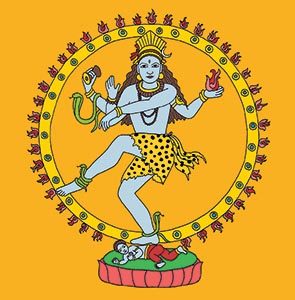
Related Article: Learn more about Nataraja!
Crown Chakra Sounds & Hindu Deities
One of the presiding deities for the crown chakra is Shiva, often depicted in a dancing form known as Nataraja, Lord of the Dance. Shiva is alternately depicted both as benevolent and fearsome. Shiva is often shown with a serpent around his neck, a crescent moon as an adornment, the river Ganges flowing from his hair or flowing nearby, the trishula as his weapon, and a damaru (drum) nearby.
Nataraja: Crown Chakra Deity
Nataraja is a whirling, joyous being dancing through the cosmos. The dance of Nataraja is called Tandava. The dance is the source of all movement within the universe. The gestures of the Tandava indicate five activities of Shiva. They are creation (symbolized by the drum), protection (the upraised hand), grounding and claiming the earth (the foot on the ground), destruction (the hand holding fire), and release (the upraised foot).
NATARAJA MANTRA: Nataraja, Nataraja, Nartana Sundara Nataraja; Shivaraja, Shivaraja, Shivakami Preya Shivaraja; Chidambaresa Nataraja, Parthi Puresa Shivaraja
Chamunda: Crown Chakra Goddess
The Goddess Chamunda is a fearsome form of the goddess Chandi. She is the goddess of war, time, death and disasters. Chamunda may have originated as a tribal goddess and been assimilated into mainstream Hinduism at a later date. Chamunda is often viewed as interchangeable with the goddesses Kali and Durga.
CHAMUNDA MANTRA: Om Aim Hrim Klim Chamundaye Vicche
Watch over 200 videos on our YouTube channel!
Chakra Sounds Chart
A summary of the information in this article on chakra sounds is available as a downloadable chart for a handy reference. Find the sounds that you like to work with! You do not have to be a vocalist or a musician to benefit from using chakra sounds.
Download Full-Size Chakra Sounds Chart
Chakra Sound Frequencies
The sound frequencies associated with each chakra are measured in hertz (HZ). Hertz are the cycles per second of a sound wave. Note that the assignment of frequencies to the chakras can be a controversial undertaking.
Some believe that the ratios and frequencies are different for different individuals based on size, the distant between chakras due to physical proportions and so forth. This is definitely a field where additional research and study may be warranted. One possible system of frequencies is given below starting on the note A at 432HZ.
- Root Chakra 432HZ
- Sacral Chakra 480HZ
- Solar Plexus Chakra 528HZ
- Heart Chakra 594HZ
- Throat Chakra 672HZ
- Third Eye Chakra 720HZ
- Crown Chakra 768HZ
Chakra Sounds with Associated Symbols
The summaries below for each of the seven chakras give a consolidated look at the respective sounds from the root chakra to the crown chakra: bija seed syllables, sargam, solfeggio, vowels, musical instruments, sound frequencies and Hindu deities. For more information about the meaning of each chakra symbol, please see Chakra Symbols Comprehensive Guide.
ARTICLE: Root Chakra Meaning
ROOT CHAKRA SOUNDS
Bija Seed Syllable: LAM
Eastern Scale (Sargam): SA
Western Scale (Solfeggio): DO
Vowel Sound: UH
Musical Instrument: Drums
Sound Frequency: 432HZ
Hindu Deities: Ganesha, Kundalini
ARTICLE: Sacral Chakra Meaning
SACRAL CHAKRA SOUNDS
Bija Seed Syllable: VAM
Eastern Scale (Sargam): RE
Western Scale (Solfeggio): RE
Vowel Sound: OO
Musical Instrument: Wind
Sound Frequency: 480HZ
Hindu Deities: Vishnu, Parvati
ARTICLE: Solar Plexus Chakra Meaning
SOLAR PLEXUS SOUNDS
Bija Seed Syllable: RAM
Eastern Scale (Sargam): GA
Western Scale (Solfeggio): MI
Vowel Sound: OH
Musical Instrument: Organ
Sound Frequency: 528HZ
Hindu Deities: Rudra, Lakshmi
ARTICLE: Heart Chakra Meaning
HEART CHAKRA SOUNDS
Bija Seed Syllable: YAM
Eastern Scale (Sargam): MA
Western Scale (Solfeggio): FA
Vowel Sound: AH
Musical Instrument: Strings
Sound Frequency: 594HZ
Hindu Deities: Hanuman, Kuan Yin
ARTICLE: Throat Chakra Meaning
THROAT CHAKRA SOUNDS
Bija Seed Syllable: HAM
Eastern Scale (Sargam): PA
Western Scale (Solfeggio): SO
Vowel Sound: EYE
Musical Instrument: Horns
Sound Frequency: 672HZ
Hindu Deities: Sadashiva, Saraswati
ARTICLE: 3rd Eye Chakra Meaning
3rd EYE CHAKRA SOUNDS
Bija Seed Syllable: OM
Eastern Scale (Sargam): DHA
Western Scale (Solfeggio): LA
Vowel Sound: AYE
Musical Instrument: Piano
Sound Frequency: 720HZ
Hindu Deities: Krishna, Shakti
ARTICLE: Crown Chakra Meaning
CROWN CHAKRA SOUNDS
Bija Seed Syllable: AH
Eastern Scale (Sargam): NI
Western Scale (Solfeggio): TI
Vowel Sound: EE
Musical Instrument: Conch Shell
Sound Frequency: 768HZ
Hindu Deities: Nataraja, Chamunda
Author’s Story: Healing My Throat Chakra
When I first began chanting, I had been on thyroid medication for over twenty years. Before my thyroid was normalized, I was plagued with constant dry skin, cold hands and feet, and a level of fatigue that was a daily challenge. Many of these symptoms persisted even on medication.
During the healing process, I discovered that mantras are an ideal tool for supporting the thyroid, since the vibrations of chanting and singing pass directly through the throat. Learn more in the Throat Chakra Meaning article.
Watch over 200 videos on our YouTube channel!
More Chakra Resources
Chakras and Musical Notes: Chakras and musical notes have been paired in a number of ways. Learn about both Western and Eastern systems.
Chakra Names: Chakra names reveal the roles of the chakras in the body on psychological, spiritual and emotional levels. Includes explanations of English and Sanskrit chakra names.
Chakra Flowers: Chakra flowers offer unique symbolic meaning for each of the seven major chakras. Flowers are among the oldest spiritual symbols, revealing the meaning of each chakra.
Author Kathleen Karlsen
Kathleen Karlsen is a musician, artist, writer and speaker. She is the author of two books (Flower Symbols and Vocal Medicine) and over 200 articles. Kathleen, her husband Andrew, and their five children live in Bozeman, Montana. More about Kathleen Karlsen.
CHAKRA SOUNDS ARTICLE SUMMARY
This article covers all of the major forms of sound affecting and activating the seven major chakras. This includes the Sanskrit seed syllables, sacred toning, musical instruments, vowels, the musical scale and mantras. Some chakra sounds are self-generated. Other chakra sounds are passively experienced. Multimedia resources include a Chakra Sound Meditation video.

